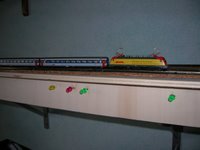Even if it seems too soon, I have sketched a typical schedule for a session conducted by an operator; it also would be a great deal even if managed by two engineers. Schedule involves freights (outlined lines) and commuter trains (continuous lines), coming both from Pondèl and from Lillàz. The most fun will be managing waybills of the freight trains, while various passenger trains will cross CretàzCretàz, creating "nice" chaotic situations.
Potrebbe sembrare prematuro, ma ho già iniziato ad abbozzare l’orario tipico per una sessione condotta da un operatore, ma potrebbe essere divertente anche se gestita da due manovratori. Il materiale rotabile ordinario è composto da treni merci (linee tratteggiate) e da treni passeggeri (linee continue), provenienti sia da Pondèl sia da Lillàz. Il divertimento consisterà maggiormente nel gestire gli ordini di carico dei treni merci, mentre i vari treni passeggeri si incroceranno o attraverseranno la stazione di Cretàz creando “simpatiche” situazioni caotiche.









